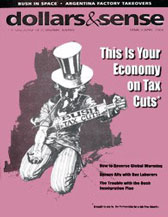
Dear Dr. Dollar:
Can you explain what trade deficits are? Who owes what to whom or is it just an accounting device?
—Jack Miller, Indianapolis, Ind.
I see that the United States has had a negative international trade balance for years. What happens to those dollars we've sent overseas?
—Bill Clark, Chillicothe, Ohio
This article is from the March/April 2004 issue of Dollars and Sense: The Magazine of Economic Justice available at http://www.dollarsandsense.org

This article is from the March/April 2004 issue of Dollars & Sense magazine.
Subscribe Now
at a discount.
If Americans collectively import more goods and services from foreigners than we export, we are said to have a trade deficit. Paying for the things we import accounts for most of the flow of dollars out of the United States. However, money flows out of the country for other reasons as well. The U.S. government provides foreign aid and supports overseas military bases; immigrants to the United States send dollars back to their families; foreigners who own U.S. businesses or financial assets take income out of the country.
When these factors are added to the trade deficit, the net outflow of dollars is called the current account deficit. In 2002, the U.S. trade deficit amounted to $418 billion, and the current account deficit totaled $480 billion. Data for 2003 is not yet available, but preliminary reports indicate the current account deficit will be at least $550 billion.
Once the dollars leave the country, three things can happen.
First, foreigners can use dollars to purchase U.S. assets: stocks, bonds, bank deposits, government debt, real estate, businesses. When Toyota buys land and equipment for a factory in the United States, when a British investment fund buys stock in a U.S. corporation, when a German bank purchases U.S. Treasury bonds, then the United States is said to be “financing” its current account deficit by selling assets. In 2002, foreigners acquired $612 billion in U.S. assets.
The United States has run persistent and increasing current account deficits since the 1980s, and foreigners have used the dollars to stake significant claims on U.S. assets. At the end of 2002, the value of U.S. assets owned by foreigners exceeded the value of foreign assets owned by U.S. residents by $2.4 trillion. This is the reason the United States is often said to be a debtor nation, with a net debt to the rest of the world of $2.4 trillion. But this “debt” is denominated in our own currency. For that reason, it does not pose the same risks for the United States as developing countries with large debts—which must be repaid in dollars or euro—face.
Foreign central banks provide a second outlet for dollars that leave the United States. The dollar is the most widely used international currency, and many less-developed countries have sizable dollar-denominated debts. Governments sometimes hang on to whatever dollars fall into their hands, parking them in liquid assets like U.S. bank accounts or U.S. government bonds to earn interest. In 2002, foreign governments held almost $95 billion in dollar reserves, which they will use to cover future deficits, repay debts, intervene in financial markets, or simply to exert influence in negotiations with the United States.
If you’ve followed the arithmetic so far, you will have figured out that in 2002, on balance, more dollars flowed back into the United States to purchase assets then flowed out. This allowed U.S. companies to buy assets overseas, almost $200 billion worth.
As long as the country’s large current account deficit is financed by these capital inflows, it is not necessarily a problem. But a third possible consequence of the massive U.S. current account deficit is that foreigners will lose confidence in the U.S. economy and stop purchasing U.S. assets. If this happens, the supply of dollars in the global banking system will exceed demand and the exchange value of the dollar will fall.
Some people believe this is already happening. Over the past few years, the dollar lost about one-third of its value relative to the euro. This could signify that foreigners are shifting from U.S. to euro-based assets. If the era of dollar supremacy is indeed coming to a close, the value of the dollar will continue to fall. What this would mean for the U.S. and world economies is difficult to predict. A sustained loss of confidence in the dollar could have many potentially serious ramifications.
Imports would grow more expensive, infuriating our trading partners, who depend on the U.S. market for their goods. With less foreign demand for U.S. assets, stock prices might tumble and interest rates rise. United States-based banks and corporations would find it harder to buy foreign assets and expand overseas. The dollar has been in trouble before and, in the past, the U.S. government pressured other countries to buy or hold dollars and prop up its value. Whether other countries agree to this will depend, ultimately, on whether the United States and other major economic powers are still talking to one another.
Did you find this article useful? Please consider supporting our work by donating or subscribing.
